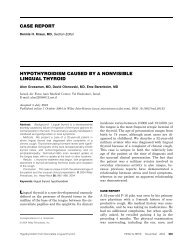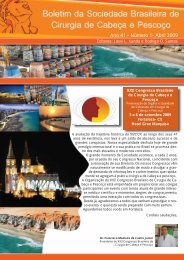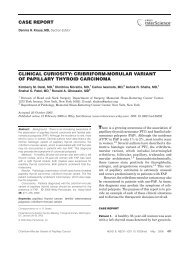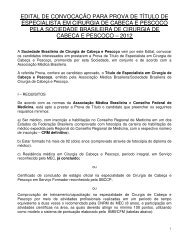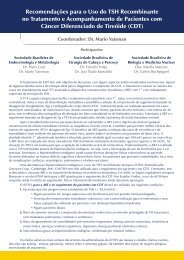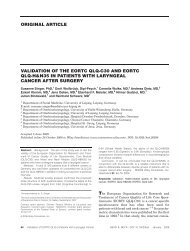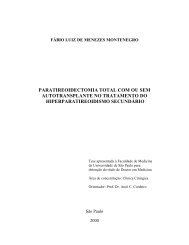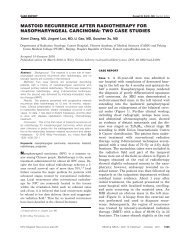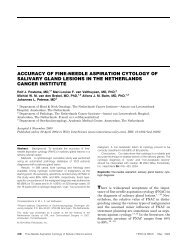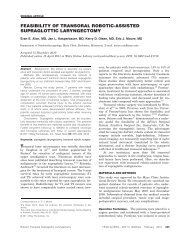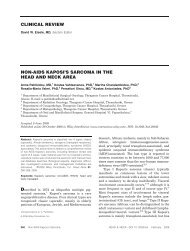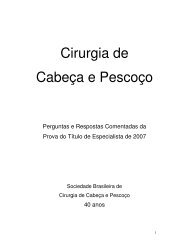Radiation-induced xerostomia
Radiation-induced xerostomia
Radiation-induced xerostomia
You also want an ePaper? Increase the reach of your titles
YUMPU automatically turns print PDFs into web optimized ePapers that Google loves.
associated with pilocarpine use are sweating,<br />
nausea, and rhinitis. Less frequent are chills,<br />
diarrhea, urinary frequency, blurred vision, dizziness,<br />
abdominal cramps, palpitations, lacrimation,<br />
and headaches. 31 Side effects are often doserelated:<br />
in clinical trials. Excessive sweating<br />
occurred in 68% of patients receiving 10 mg tid vs<br />
29% of patients receiving 5 mg tid and 9% receiving<br />
placebo. 31<br />
Cevimeline hydrochloride is a newer muscarinic<br />
agonist that was found safe and effective in<br />
treating <strong>xerostomia</strong> associated with Sjögren syndrome<br />
and has been FDA approved for this use. 27<br />
Cevimeline has a selective affinity for M3 muscarinic<br />
receptors, which are the major receptors<br />
associated with stimulation of salivary flow. 32 In 3<br />
clinical trials, cevimeline improved symptoms of<br />
dry mouth in patients with Sjögren syndrome. In<br />
the first 2 trials (involving 75 and 197 patients,<br />
respectively), a significantly higher percentage of<br />
patients receiving cevimeline 30 mg tid reported<br />
improvement in the overall condition of dry mouth<br />
compared with patients receiving placebo (p ¼<br />
.0043 and .0004). Patients receiving cevimeline<br />
30 mg tid in the third trial were more likely than<br />
placebo recipients to have increased postdose<br />
salivary flow (p ¼ .0017). Of 1777 patients with<br />
Sjögren syndrome or other conditions treated with<br />
cevimeline in clinical trials, 11.1% discontinued<br />
treatment because of adverse events. Excessive<br />
sweating, nausea, rhinitis, and diarrhea occurred<br />
in 18.7%, 13.8%, 11.2%, and 10.3%, respectively, of<br />
patients receiving cevimeline 30 mg tid compared<br />
with 2.4%, 7.9%, 5.4%, and 10.3% of placebo recipients.<br />
33–35<br />
Recently, cevimeline was shown in animal<br />
studies to increase salivation after head and neck<br />
irradiation. 27 Two phase III trials including a total<br />
of 570 patients with radiation-<strong>induced</strong> <strong>xerostomia</strong><br />
evaluated the efficacy and safety of cevimeline in<br />
this population. 36 Patients were randomized to<br />
cevimeline 30 to 45 mg tid or placebo for 12 weeks.<br />
In 1 study, global improvement in dry mouth<br />
symptoms was reported by significantly more<br />
patients in the cevimeline-treated group than in<br />
the placebo group (47.4% vs 33.3%, p ¼ .0162). In<br />
both studies, cevimeline-treated patients had significantly<br />
greater increases in unstimulated salivary<br />
flow than placebo recipients at the final evaluation.<br />
Increased sweating was the significant<br />
adverse event reported more frequently in the<br />
cevimeline groups than in the placebo groups. The<br />
longitudinal safety evaluation phase of the studies<br />
is currently in progress.<br />
CONCLUSION<br />
<strong>Radiation</strong>-<strong>induced</strong> <strong>xerostomia</strong> causes significant<br />
morbidity after irradiation for head and neck cancers.<br />
Other patients affected are those receiving<br />
iodine 131 therapy for thyroid cancer or total body<br />
irradiation for allogeneic stem cell transplant.<br />
Current options for prevention and treatment<br />
are limited. New, more selective radiation-delivery<br />
techniques (eg, IMRT) allow some degree of<br />
salivary gland preservation. A proposed surgical<br />
preventive strategy, submandibular gland transfer,<br />
may help preserve gland function after irradiation<br />
but is still investigational. 12,26 There is<br />
increased interest in the combined use of IMRT<br />
and radioprotective agents: acinar cell proliferation<br />
stimulants, metal ion mobilizers or chelators,<br />
free radical scavengers, and other antioxidant<br />
molecules. The FDA approved amifostine to prevent<br />
radiation-<strong>induced</strong> <strong>xerostomia</strong> in patients<br />
receiving postoperative radiation therapy for<br />
head and neck cancers. Patients whose symptoms<br />
of dryness are not optimally controlled by moisture<br />
replacement should be considered for treatment<br />
with secretory stimulants (secretagogues) to<br />
stimulate the M3 muscarinic receptors found in<br />
salivary glands, leading to enhanced secretion.<br />
These agents include pilocarpine and cevimeline.<br />
Furthermore, intensive ongoing research in gene<br />
therapy, aiming to repair salivary glands damaged<br />
by irradiation or autoimmune processes, has<br />
produced encouraging results, establishing the<br />
foundation of a promising future. Key to the management<br />
of postirradiation <strong>xerostomia</strong> is symptomatic<br />
relief with saliva supplementation/stimulation<br />
and a multidisciplinary approach that includes<br />
physicians of various specialties, dentists,<br />
and even complementary and alternative medicine<br />
modalities (eg, acupuncture or Codetron<br />
treatments). 3,9,25<br />
Acknowledgments. The authors thank Daiichi<br />
Pharmaceutical Corporation for funding this<br />
publication and IMPRINT Publication Science,<br />
New York, for their editorial support in the preparation<br />
and styling of this manuscript.<br />
REFERENCES<br />
1. National Cancer Institute Fact Sheet. Head and Neck<br />
Cancer: Questions and Answers. Available at: www.cancer.<br />
gov/cancertopics/factsheet/sites-types/head-and-neck. Accessed<br />
April 12, 2006.<br />
2. Rosenthal DI, Ang KK. Altered radiation therapy fractionation,<br />
chemoradiation, and patient selection for the<br />
62 <strong>Radiation</strong>-Induced Xerostomia HEAD & NECK—DOI 10.1002/hed January 2007



